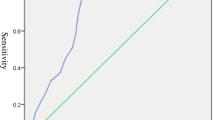Summary
No single ICD-9 category corresponds to panic disorder (DSM-III). To investigate whether patients with panic attacks can be identified by means of ICD-9, 97 patients with three panic attacks within 3 weeks were recruited from various medical centers, and were classified independently according to DSM-111 and ICD-9.
The ICD-9 diagnoses were scattered over a broad range of categories, and it was impossible to identify patients with panic disorder in this manner. Anxiety state, affective psychosis, and depressive neurosis were the most frequent ICD-9 diagnoses. The boundary between affective psychosis on the one hand and anxiety state and depressive neurosis on the other hand was validated by present and previous symptomatology and by cluster analysis. The boundary between anxiety state and depressive neurosis could not be validated in this way. Correspondingly, modifications of the ICD-9 classifications are proposed.
Similar content being viewed by others
References
American Psychiatric Association (1980) Diagnostic and Statistical Manual of Mental Disorders, 3rd edn, APA, Washington, DC
Andreasen NC, Grove WM (1982) The classification of depression: Traditional vs. mathematical approaches. Am J Psychiatry 139:45–52
Binder J, Dobler-Mikola A, Angst J (1981) An epidemiological study of minor psychiatric disturbances. A field study among 20 year old females and males in Zürich. Soci Psychiatry 16:31–41
Breier A, Charney DS, Heninger GR (1984) Major depression in patients with agoraphobia and panic disorder. Arch Gen Psychiatry 41:1129–1135
Everitt BS (1972) Cluster analysis: A brief discussion of some problems. Br J Psychiatry 120:143–145
Everitt BS, Gourlay AJ, Kendell RE (1971) An attempt at validation of traditional psychiatric syndromes by cluster analysis. Br J Psychiatry 119:399–412
Feighner JP, Robins E, Guze SB, Woodruff RA jr., Winokur G, Munoz R (1972) Diagnostic criteria for use in psychiatric research. Arch Gen Psychiatry 26:57–63
Garside RF, Roth M (1978) Multivariate statistical methods and problems of classification in psychiatry. Br J Psychiatry 133:53–67
Gastpar M (1983) The ICD-9 and the SADD Criteria of depression. Acta Psychiatr Scand 68 (Suppl. No. 310):31–41
Grove WM, Andreasen NC (1982) Simultaneous tests of many hypotheses in exploratory research. J Nerv Ment Dis 170:3–8
Gurney C, Roth M, Garside RF, Kerr TA, Schapiro H (1972) The assessment and prediction of outcome in affective disorders. Br J Psychiatry 121:162–166
Klein DF (1964) Delineation of two drug-responsive anxiety syndromes. Psychopharmacologia 5:397–408
Klein DF (1981) Anxiety reconceptualized. In: Klein DF, Rabkin J (eds) Anxiety: New research and changing concepts. Raven Press, New York, pp 235–263
Klerman GL, Endicott J, Spitzer RL, Hirschfeld RMA (1979) Neurotic depression: A symptomatic analysis of multiple criteria and meanings. Am J Psychiatry 19:57–61
Leckman JF, Weissman MM, Merikangas KR, Pauls DL, Prusoff BA (1983) Panic disorder and major depression. Arch Gen Psychiatry 40:1055–1060
Mezzich JE (1978) Evaluating clustering methods for psychiatric diagnoses. Biol Psychiatry 13:265–281
Paykel ES (1981) Have multivariate statistics contributed to classification? Br J Psychiatry 139:357–362
Spitzer RL, Williams JBW (1983) Structured clinical interview for DSM-III (SCID 2/14/83). Biometrics research department, New York State Psychiatric Institute, New York
Torgersen S (1983) Genetic factors in anxiety disorders. Gen Arch Psychiatry 40:1085–1089
Van Valkenburg C, Akiskal HS, Puzantian V, Rosenthal T (1984) Anxious depressions. J Affect Disord 6:67–82
Wishart D (1978) Clustan user manual, 3rd edn, Edinburgh, Program Library Unit, Edinburgh University
World Health Organization (1978) Mental disorders: Glossary and guide to their classification in accordance with the ninth revision of the international classification of diseases. WHO, Geneva
Author information
Authors and Affiliations
Rights and permissions
About this article
Cite this article
Maier, W., Buller, R., Sonntag, A. et al. Subtypes of panic attacks and ICD-9 classification. Eur Arch Psychiatr Neurol Sci 235, 361–366 (1986). https://doi.org/10.1007/BF00381005
Received:
Issue Date:
DOI: https://doi.org/10.1007/BF00381005




